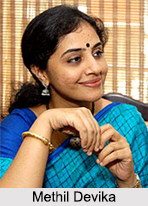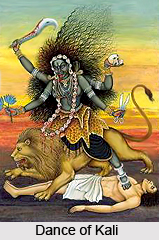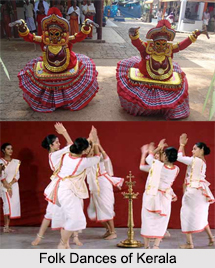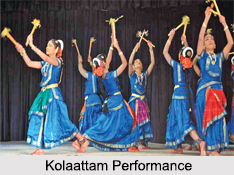The Nritta technique of Bharatnatyam has several Adavus. They are units which have been divided into nine groups. Each of them is again sub-divided into various groups. Adavus can be set in any tala and all are performed in the araimandi position. Symmetrical pattern is achieved by executing a movement first by the right foot and then by the left foot. This gives the body a static quality.
The various types of Adavus are discussed below:
The first adavu is called the tattadavu. It has flat foot contact in the basic araimandi position. The movement is in regard to the ground and the vertical median. The dancer begins by stamping in single units. The dancer might execute other patterns by stamping the right foot twice and then the left foot twice. The subdivisions are performed according to different categories of talas.
The second type of adavu is known as the nattu adavu where the foot is placed in such a way so that the heel is down and the toes are up. Extension of one leg while keeping the other bent with the foot sideways is one of the basic movements in adavu. There are many varieties of Adavus. In other varieties, one leg is extended to the front and then constricted and brought behind the standing foot. The movement of the hands and arms follow the leg movements. There are some leg extensions with torso and arms following it, which results in statuesque poses.
The third group is a combination of the flat feet with a slight jump on the toes. This initiates the toe-heel movement. Another variety is jumping on both toes in the araimandi position which is followed by the right foot and then the left foot stamping the ground. Most of the adavu types are executed in the araimandi position without any leg extensions. There are a number of movements where there are leg extensions.
In the fourth variety both the toes hit the ground at the same time followed by stamping of the heels. There are various methods to perform this. Some of the rhythmic sequences of Bharatnatyam with extended arms and closing arms are done in this adavu. The feet slip sideways in an erect position which is a sub division of this adavu. Thereafter the dancer uses the heel-toe movement. The final sequences of the Tillana are based on this adavu.
The fifth group is where the dancer learns a variety of combinations which can be use in different types of the Indian tala system. Stamping of the right foot and then the left foot, followed by a jump on the heels, on the third beat, and stamping of only the right foot on the fourth beat is the first sub-division. This movement is repeated by beginning it with the left foot. Complicated rhythmical structures are built based on this movement which gives a different flavour to Bharatnatyam.
The sixth group has two varieties in which the dancer tries to build up movement by the use of only one foot in groups of three beats.
The next group has nearly sixteen varieties in which the adavus can be woven around a basic movement executed to three beats. Some of the varieties provide the climax to the tirmanams in Bharatnatyam. Here the use of the extended leg and its contraction is witnessed. For instance, the right leg is extended to the front, the heel beating the ground, followed by the left foot in place stamping the ground. The right foot is back to its position in the third beat and stamps the ground in the araimandi position.
The eighth group is also known as the poi adavu. It means silent dance with graceful hops and jumps. Here the feet is lifted to a new position silently and comes back to its original position. Such front and back extensions are common. Some jumps of Bharatnatyam belong to this group. Jatisvaram is executed in this adavu.
The final group is where in the beginning the arms provide variation and stamping in the araimandi position. A combination of this variety and the seventh group provides many complex spontaneous patterns on basic tala.
The various groups of adavus differ from family to family in the Bharatnatyam Sampradayam. The basic unit is followed rigorously, its divisions may differ. These adavus may be merged together to form sustained dance sequences. These are known as tirmanams. The difference between is slight. The adavus and the tirmanams are set according to the beats of a tala.




